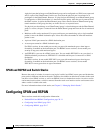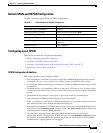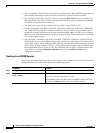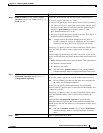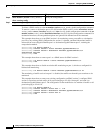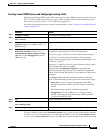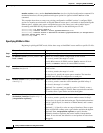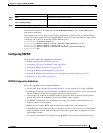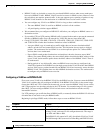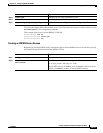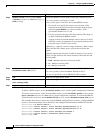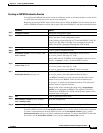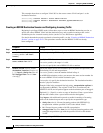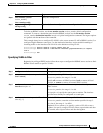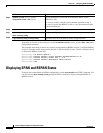
29-18
Catalyst 3750 Switch Software Configuration Guide
OL-8550-09
Chapter 29 Configuring SPAN and RSPAN
Configuring SPAN and RSPAN
• RSPAN VLANs are included as sources for port-based RSPAN sessions when source trunk ports
have active RSPAN VLANs. RSPAN VLANs can also be sources in SPAN sessions. However, since
the switch does not monitor spanned traffic, it does not support egress spanning of packets on any
RSPAN VLAN identified as the destination of an RSPAN source session on the switch.
• You can configure any VLAN as an RSPAN VLAN as long as these conditions are met:
–
The same RSPAN VLAN is used for an RSPAN session in all the switches.
–
All participating switches support RSPAN.
• We recommend that you configure an RSPAN VLAN before you configure an RSPAN source or a
destination session.
• If you enable VTP and VTP pruning, RSPAN traffic is pruned in the trunks to prevent the unwanted
flooding of RSPAN traffic across the network for VLAN IDs that are lower than 1005.
• Catalyst 3750-24PS, 3750-48PS, 3750-24TS, 3750-48TS, 3750G-12S, 3750G-24T, 3750G-24TS
and 3750G-16TD switches have hardware limitations related to RSPAN:
–
An egress SPAN copy of routed unicast traffic might show an incorrect destination MAC
address on both local and remote SPAN sessions. This limitation does not apply to bridged
packets. The workaround for local SPAN is to use the replicate option. For a remote SPAN
session, there is no workaround.
–
Egress SPAN routed packets (both unicast and multicast) show the incorrect source MAC
address. For remote SPAN packets, the source MAC address should be the MAC address of the
egress VLAN, but instead the packet shows the MAC address of the RSPAN VLAN. There is
no workaround.
–
During periods of very high traffic, when two RSPAN source sessions are configured, the
VLAN ID of packets in one RSPAN session might overwrite the VLAN ID of the other RSPAN
session. If this occurs, packets intended for one RSPAN VLAN are incorrectly sent to the other
RSPAN VLAN. This problem does not affect RSPAN destination sessions. The workaround is
to configure only one RSPAN source session.
Configuring a VLAN as an RSPAN VLAN
First create a new VLAN to be the RSPAN VLAN for the RSPAN session. You must create the RSPAN
VLAN in all switches that will participate in RSPAN. If the RSPAN VLAN-ID is in the normal range
(lower than 1005) and VTP is enabled in the network, you can create the RSPAN VLAN in one switch,
and VTP propagates it to the other switches in the VTP domain. For extended-range VLANs (greater
than 1005), you must configure RSPAN VLAN on both source and destination switches and any
intermediate switches.
Use VTP pruning to get an efficient flow of RSPAN traffic, or manually delete the RSPAN VLAN from
all trunks that do not need to carry the RSPAN traffic.
Beginning in privileged EXEC mode, follow these steps to create an RSPAN VLAN:
Command Purpose
Step 1
configure terminal Enter global configuration mode.
Step 2
vlan vlan-id Enter a VLAN ID to create a VLAN, or enter the VLAN ID of an
existing VLAN, and enter VLAN configuration mode. The range is
2 to 1001 and 1006 to 4094.
The RSPAN VLAN cannot be VLAN 1 (the default VLAN) or VLAN
IDs 1002 through 1005 (reserved for Token Ring and FDDI VLANs).



